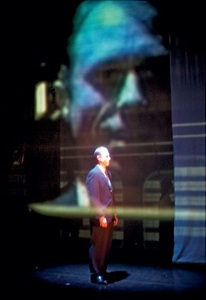Felicity Jones as the titular Luise
Schiller’s 1784 play is an interesting one to see in the same week as A Woman Killed With Kindness. Both juxtapose bourgeois family life with the venality of the nobility. Both are tragedies, both concerned with a spiky triangle of sex, marriage and desire.
In order to reinforce his influence at Court, the Chancellor to a German Prince decides to marry his son off to the Prince’s mistress, Lady Wilford. Unfortunately, the son, Ferdinand, has already fallen in love with a fiddler’s daughter, Luise, and refuses the match. A plot is hatched; Luise’s father is arrested and, with the promise that he will be released, she is persuaded to write a letter that seems to imply her infidelity. Ferdinand, having staked everything on Luise, poisons himself and her, only finding out the truth as he dies.
I think the play covers a very short period of time, something quite close to 24 hours. It alternates dialectically between Court and the Millers’ home. In the Court, we are presumably at the Chancellor’s quarters, perhaps in some semi-public place, and also in a couple of memorable scenes Lady Milford’s bedchamber. This production kept location often very indeterminate. The plot unfolds fairly logically and in chronological sequence.
I’ve never seen - in fact, never come across - this play before and it stands up extremely well in Mike Poulton’s translation which balances a necessary heightenedness with contemporary clarity. The play is plainly standing on the shoulders of Romeo and Juliet and the death scene was genuinely moving. The Court scenes were often very funny, though I suspected this was more Poulton than Schiller. One problem this gives the play is that the plot seems like a comic turn - in fact, I never really felt that Ben Daniels’ Chancellor was a genuinely threatening man. That said, John Light and David Dawson were really delightful as Court sycophants. The father is a beautiful character, played with great humanity and feeling by Paul Higgins, who reveals him as sane, modest, and righteous. I was not terribly engaged by the two lovers until the very end.
What interested me most were the ideas in the play: the play is at a turning point for European aristocrats, which had always used marriage as a means of shoring up reputation, making crucial alliances, ensuring the controlled passing-on of wealth, estate and name. The rise of the Enlightenment offered a different attitude to human sexuality and desire and to individual autonomy, with nascent Rousseauian romanticism seeing desire as a kind of self-assertion perhaps for the first time. The simultaneous rise of the bourgeoisie established a class for whom name, estate and wealth were less significant and whose numbers were far greater and so marriage could be more a matter of choice. So this is a play that is dramatising a clash between two, quite different ideas about love. At the same time, Schiller was determined that the play would have a moral function by re-asserting divine love as the ultimate horizon of judgment, appealing, as it were, over the heads of the Court and asserting the ultimate goodness of the world. This is, to my atheist eyes, the least persuasive and indeed appealing part of the play and is played down considerably in this production. What is left is some rather dubious Jesuitical bits and pieces about when it is permissible to break a solemn oath which is probably more coherent in the original but becomes confusingly arbitrary when so much else of the theology is removed.
This is the kind of show that the Donmar’s become known for: a semi-obscure European classic given a sparky new version and cast to the hilt with a fine set and austerely beautiful lighting. Life is a Dream, The Prince of Homburg, Creditors, Ivanov, John Gabriel Borkman, Henry IV, Caligula, and more. They always kind of work. But underneath, I wonder if there’s a level of deep boredom that threatens to break. It’s about the lack of intellectual rigour in the productions, the preference for superficially beautiful sets, the incoherent acting styles, the sense that we’re all watching An Important Classic. The evenings feel slightly literary (in a bad way), heavy-handed, finessing away the complexity of engaging with a remote and difficult play and instead delivering something worthy with a few bonus laughs. Classics with benefits. It reminds me of what Peter Brook almost half a century ago called ‘Deadly Theatre’. It’s dazzling and entertaining and distracting and deep down a bit dull.
In this production the ideas in the play remain inert, as if no one was terribly interested in them, or had even much stopped to think why they were doing the play at all. The play felt pointlessly reinvented for the present; yes, with a bit of effort one might spot glimpses of the establishment’s present corruption, but not really. Maybe there’s something about religion and rationalism, but we’d have to do all the work. Is Schiller a good playwright? Is this a good play? The production doesn’t even seem to care much about that. People do things on stage, often very effectively, but there’s a deep dimness to the whole experience, a grey fuzziness where the thought should be. I’ve enjoyed a lot of things in that theatre but I’ve increasingly felt the tendrils of Deadly Donmar choking off anything more genuinely rewarding. It’s a theatre that needs reinvigorating. Let’s hope Josie Rourke is the right person for the task.




![photo[1].jpg](https://images.squarespace-cdn.com/content/v1/513c543ce4b0abff73bc0a82/1362919072201-PZO854G4SEB794DVOEI8/photo%5B1%5D.jpg)
